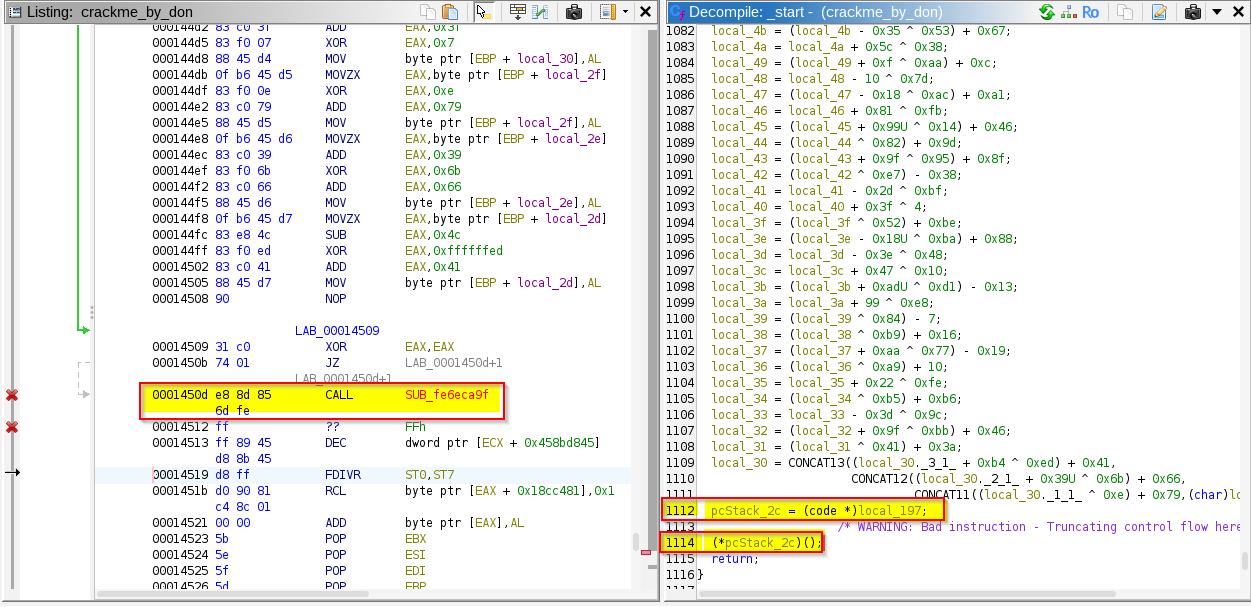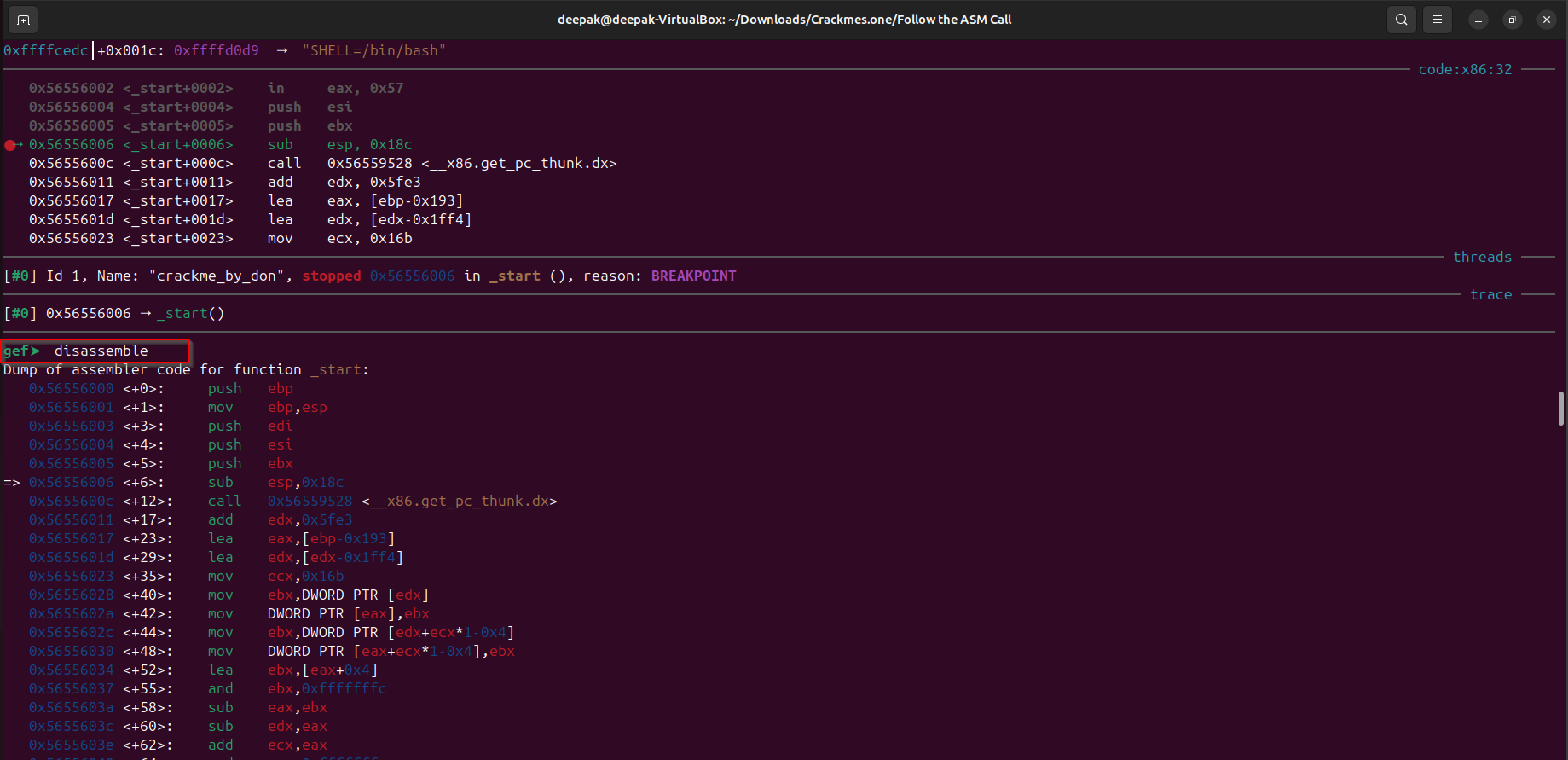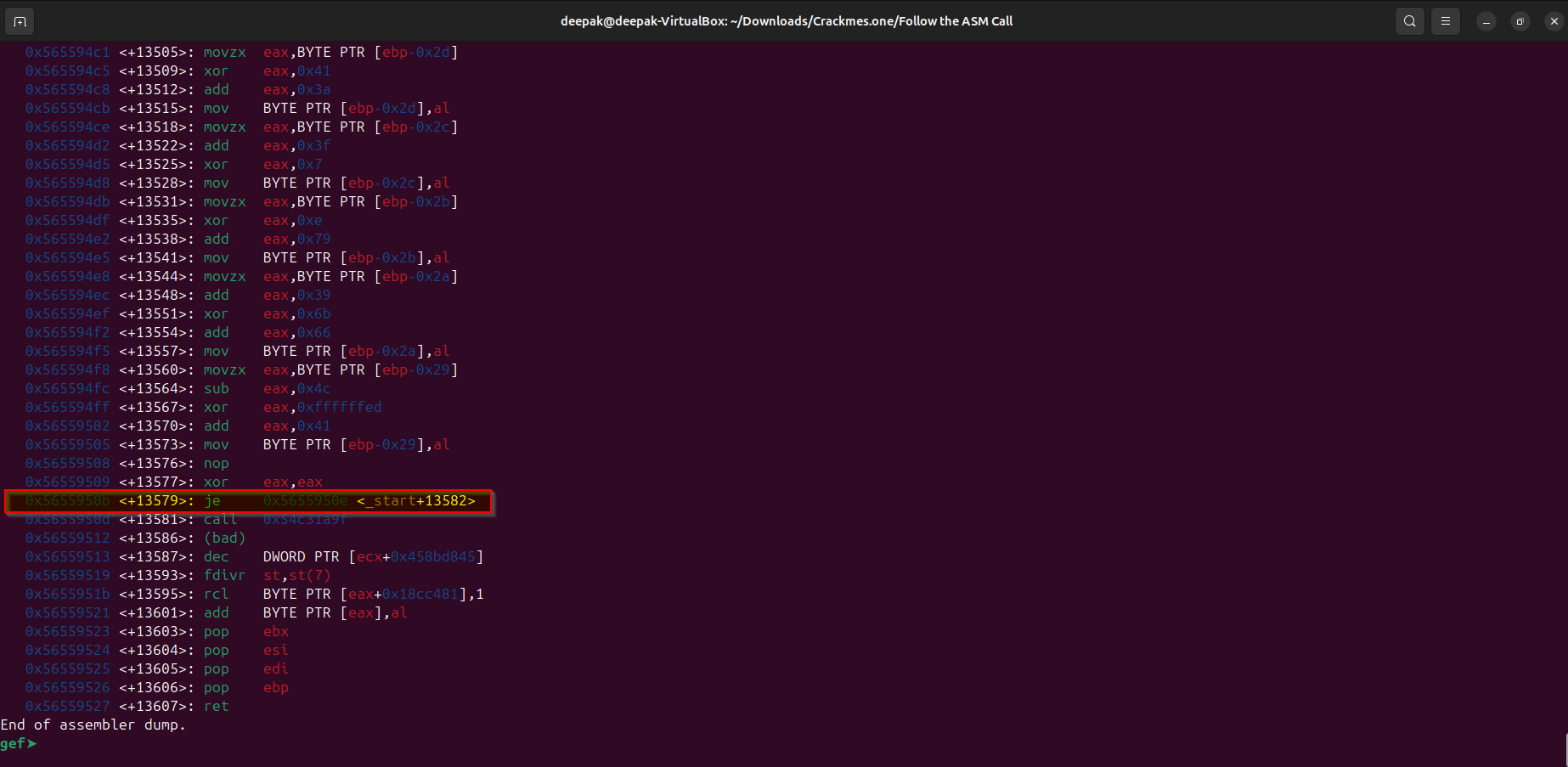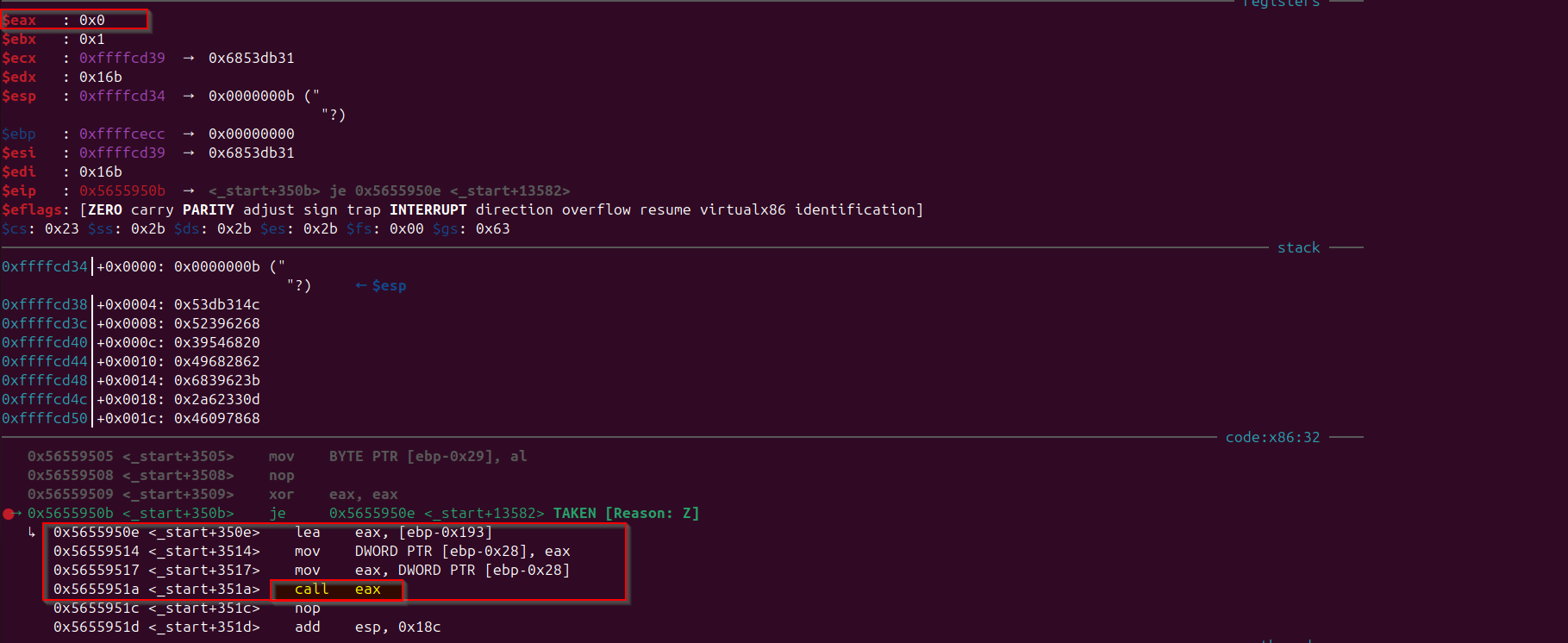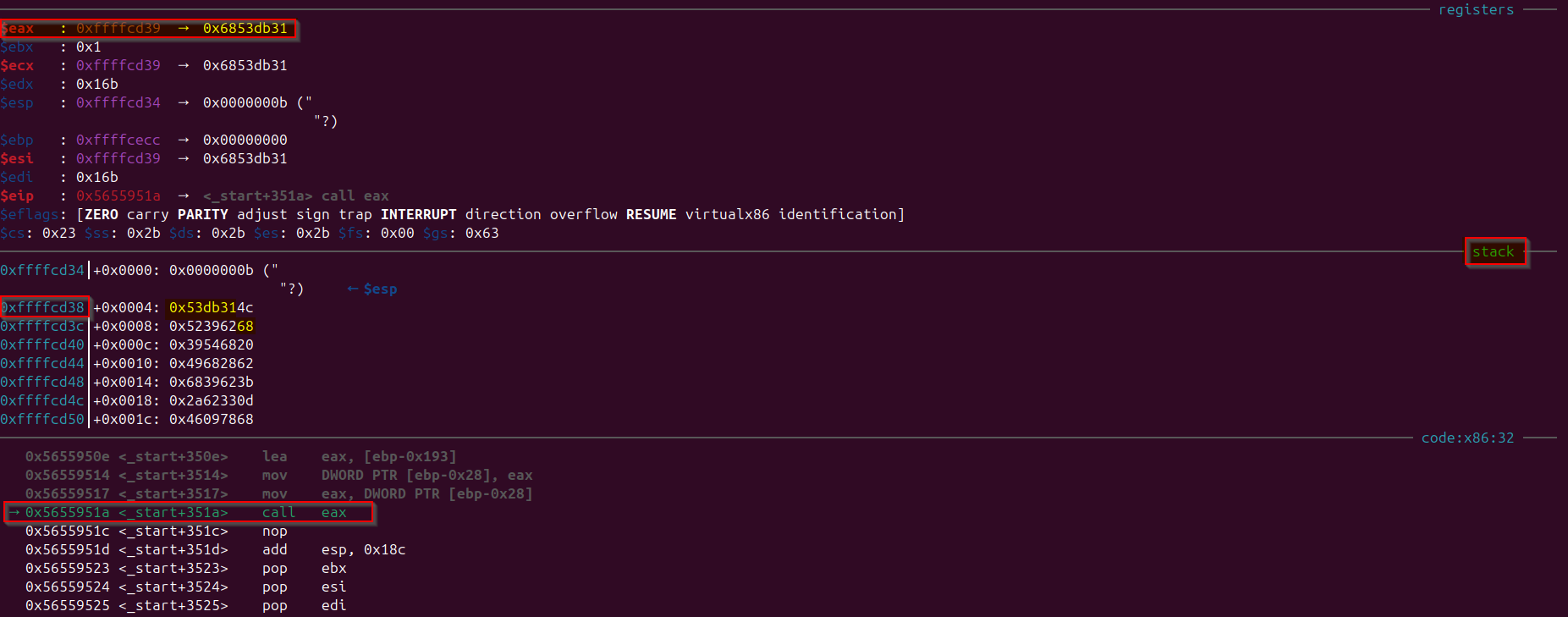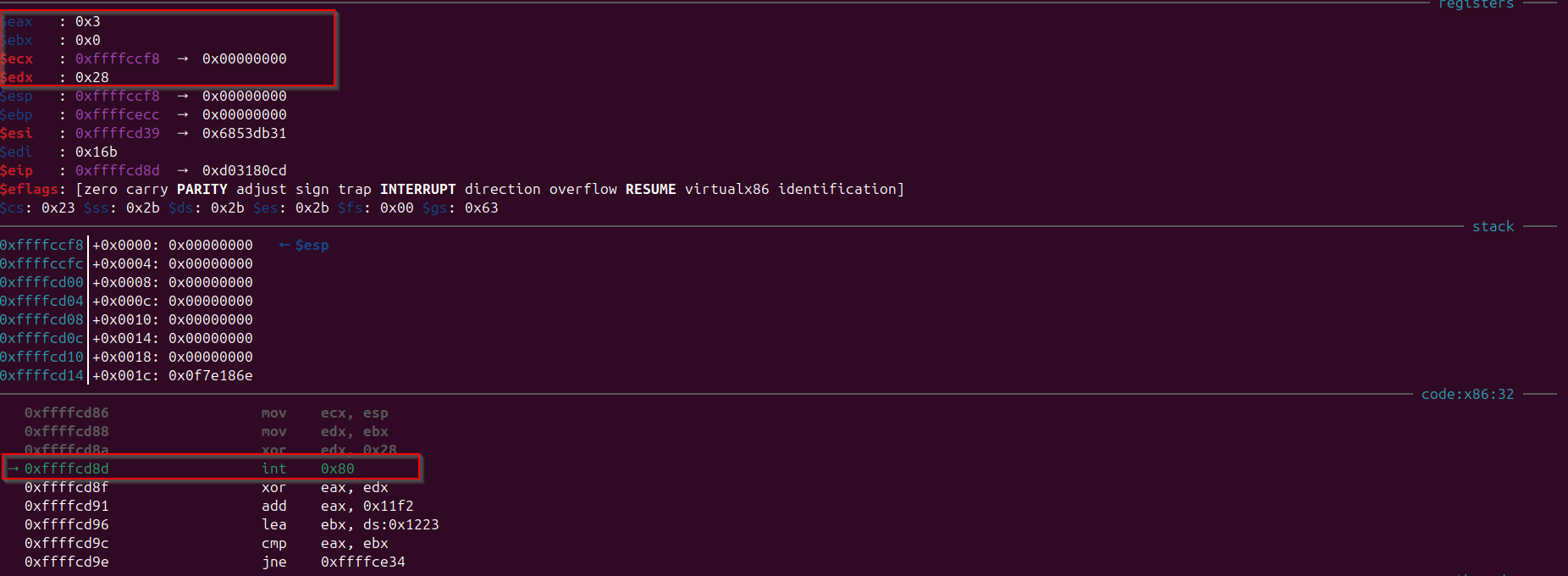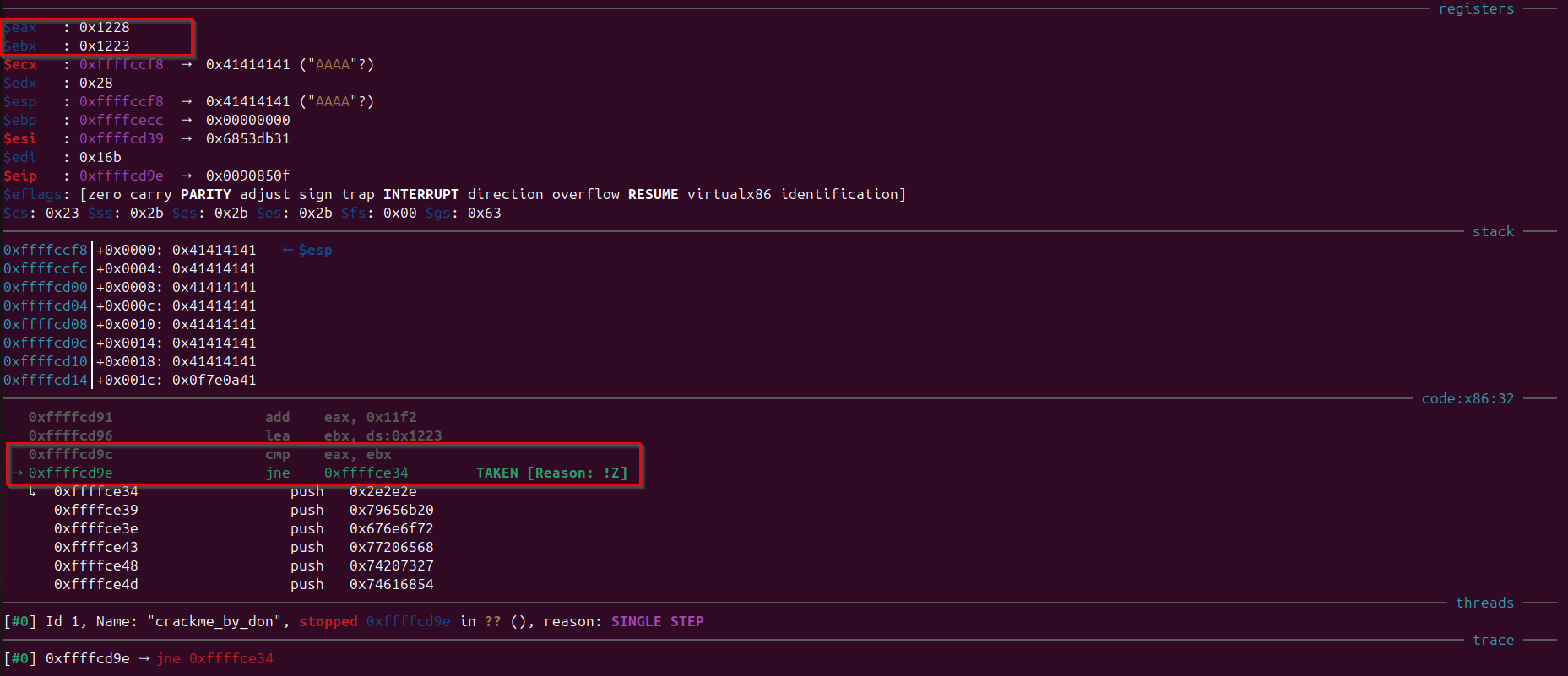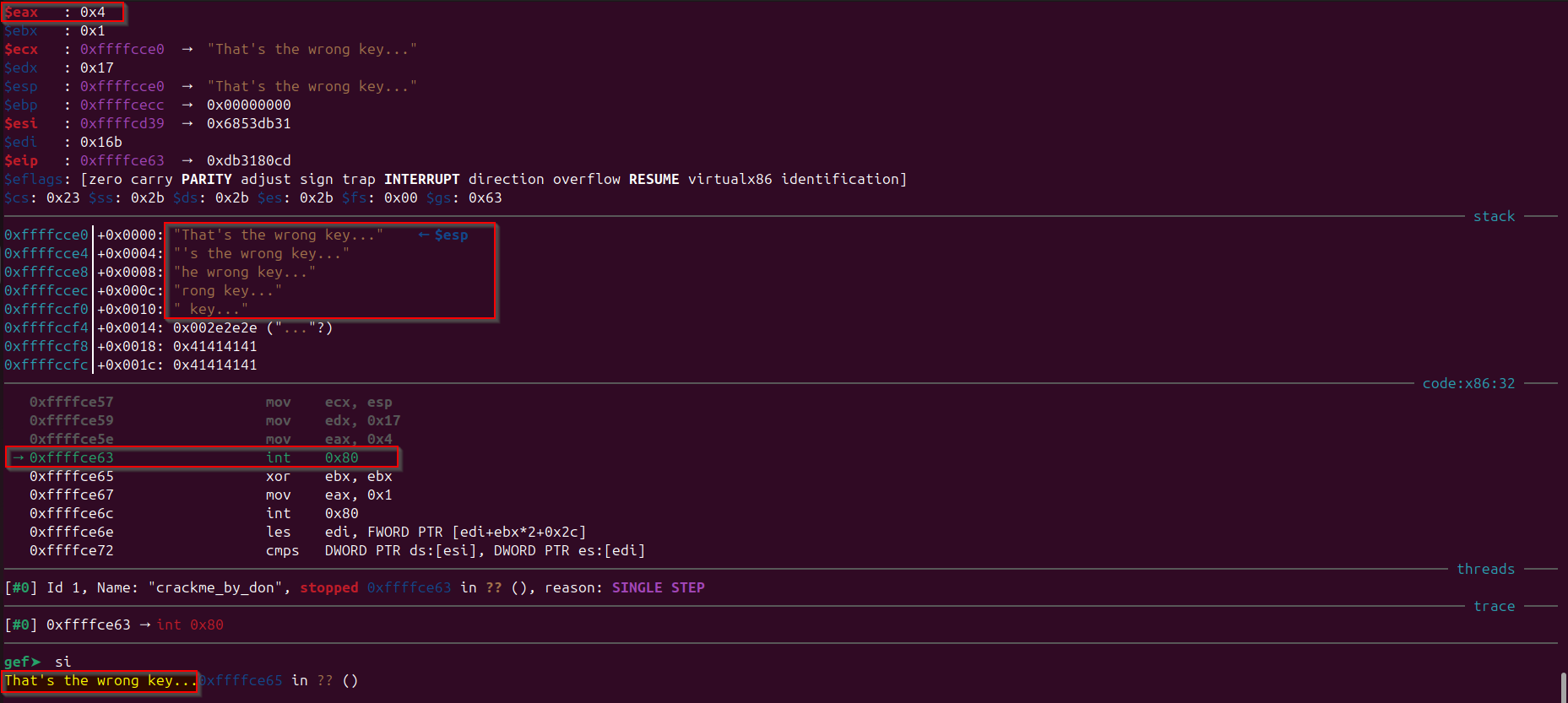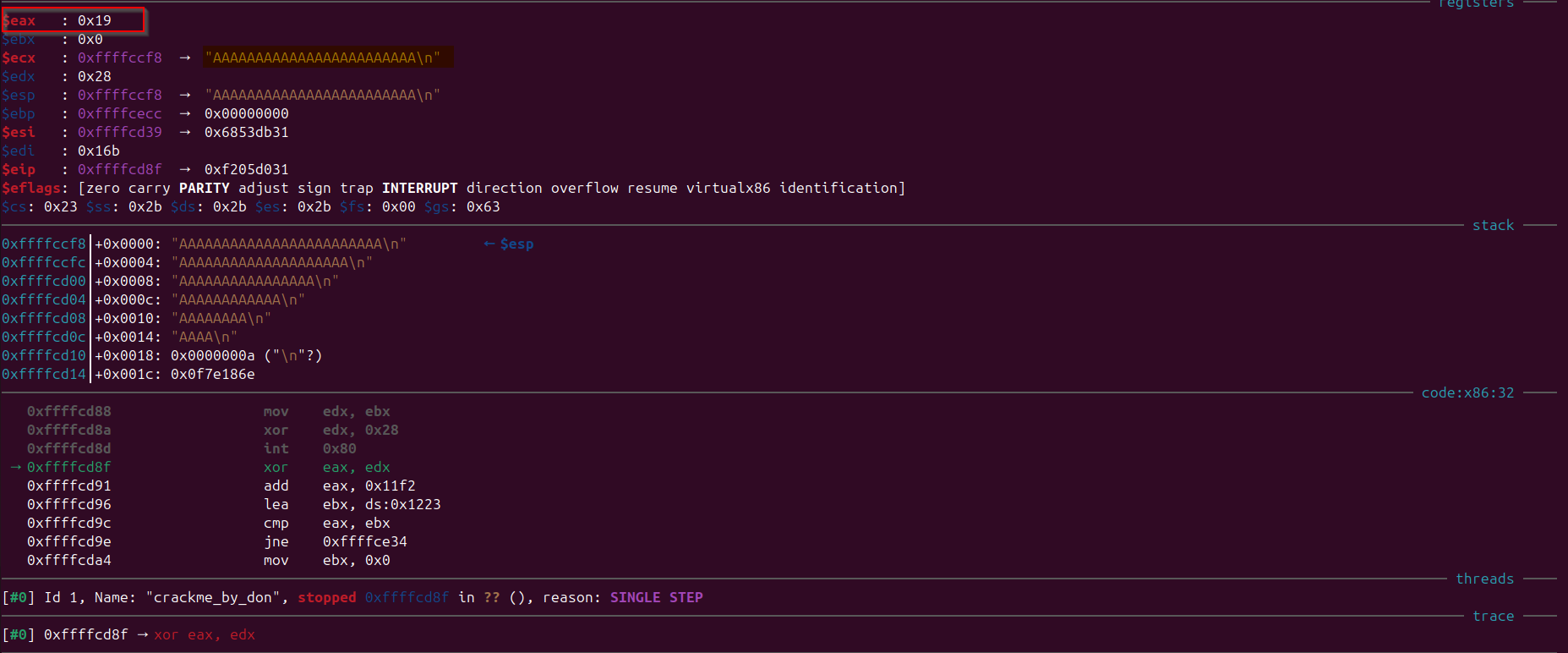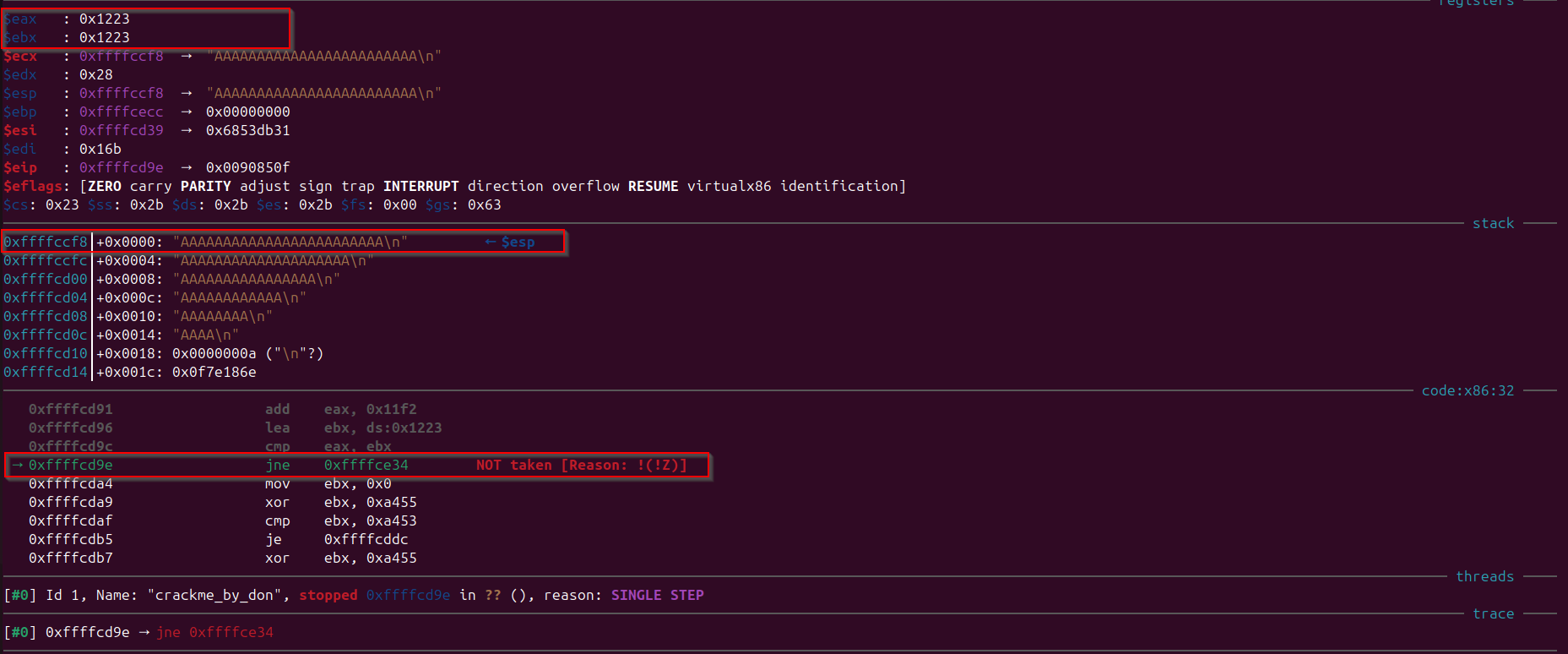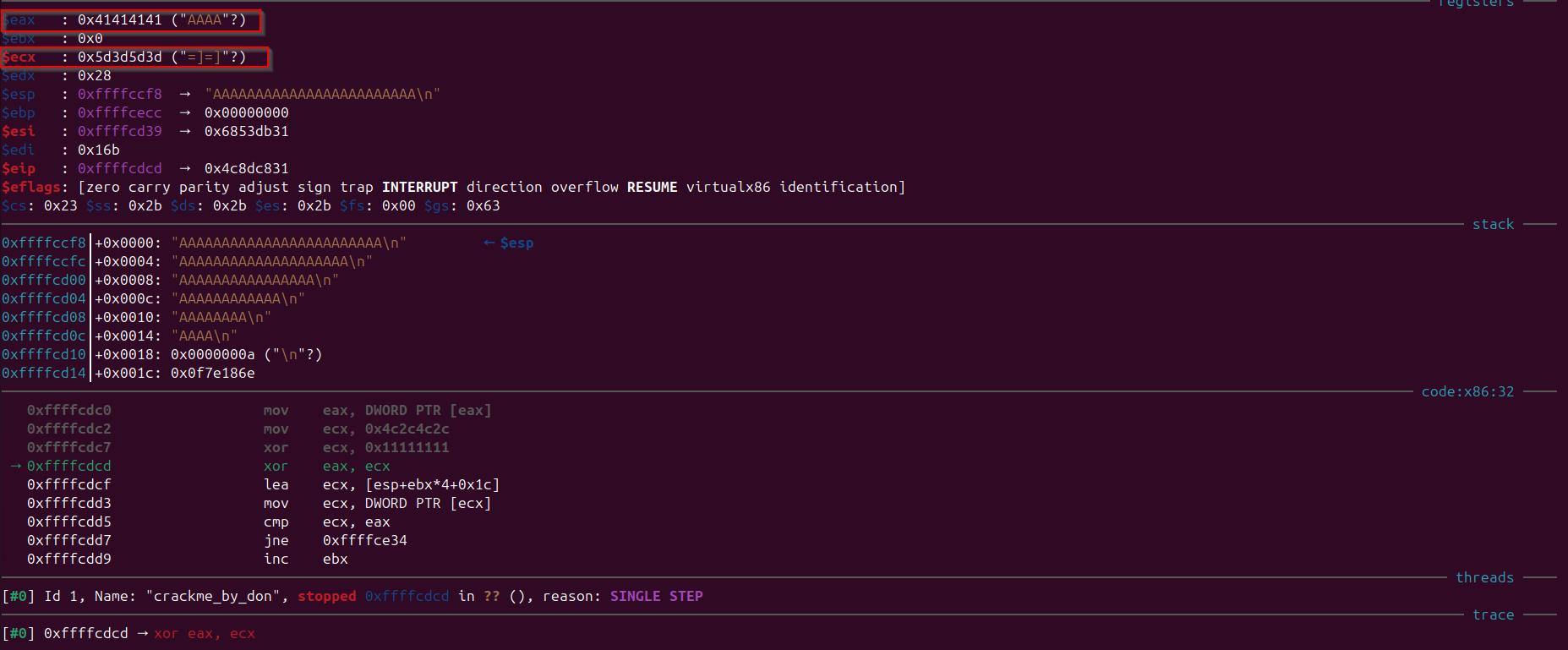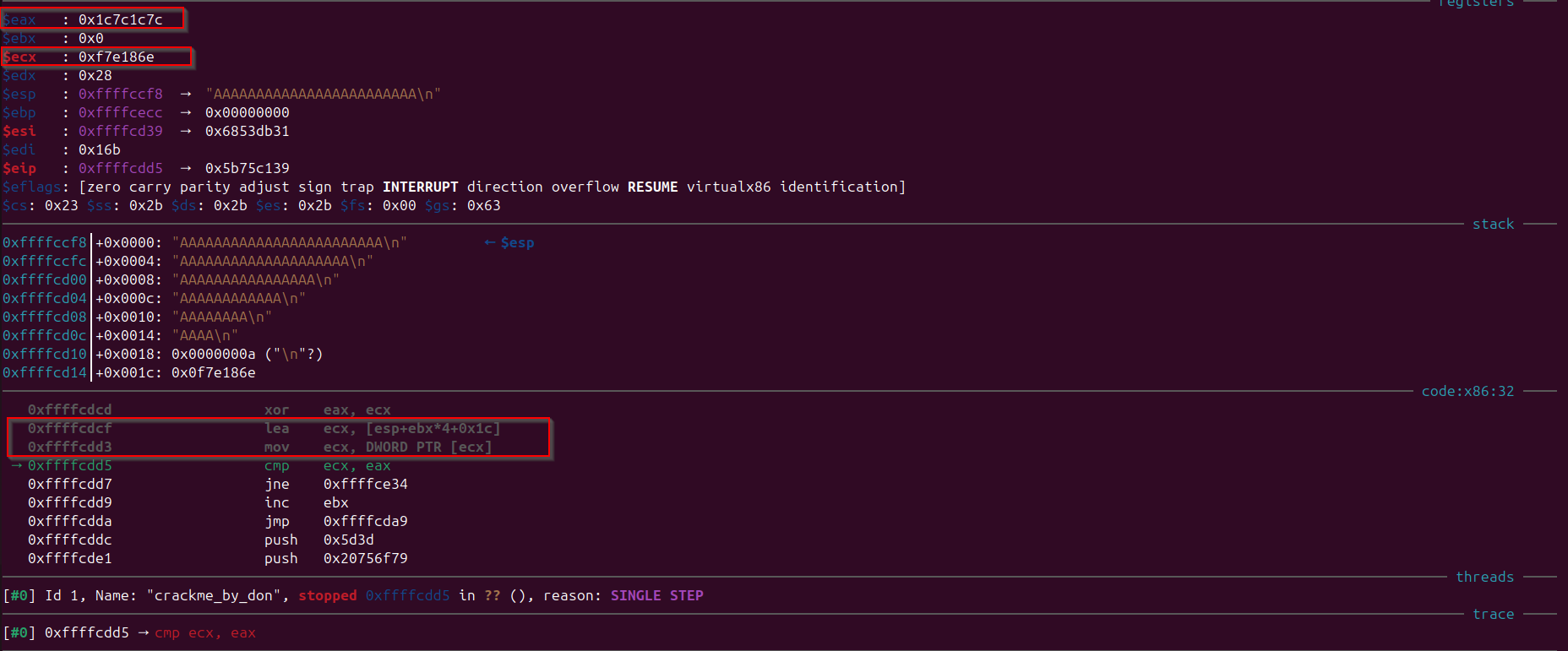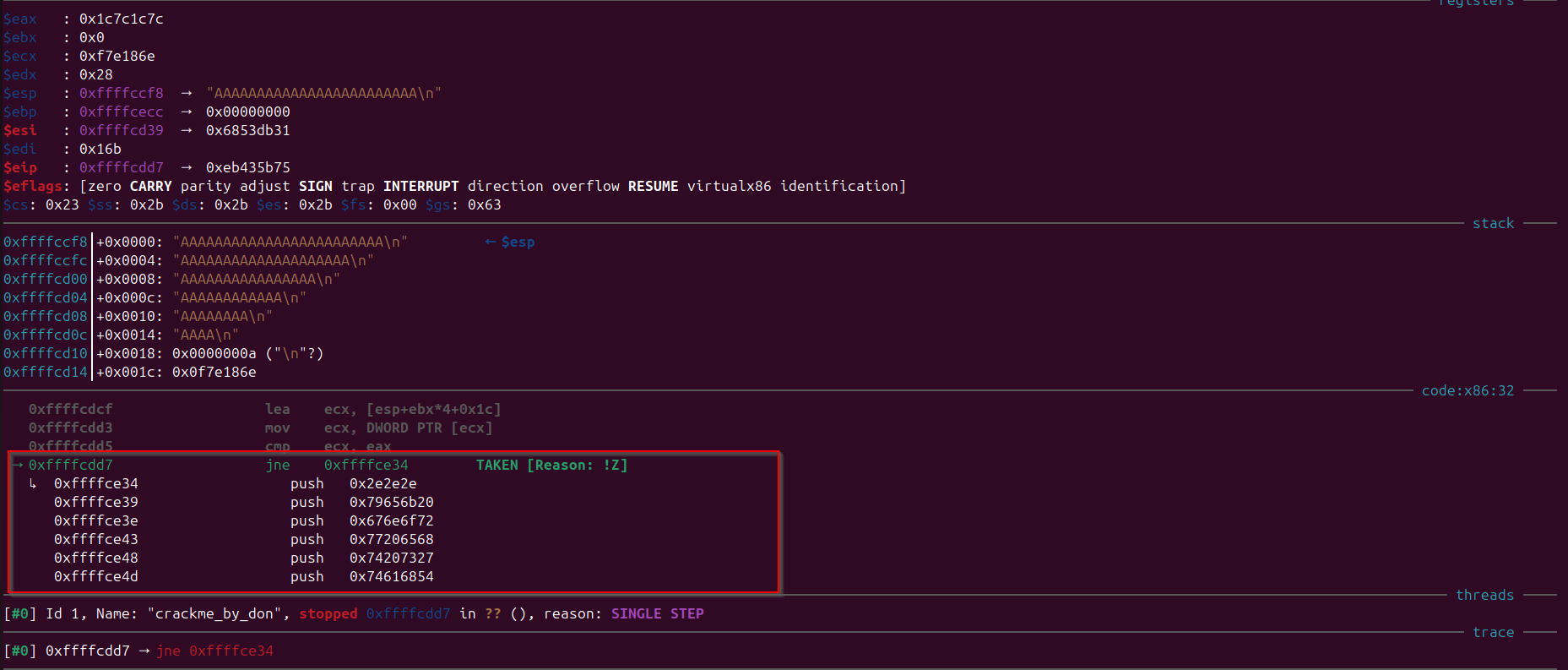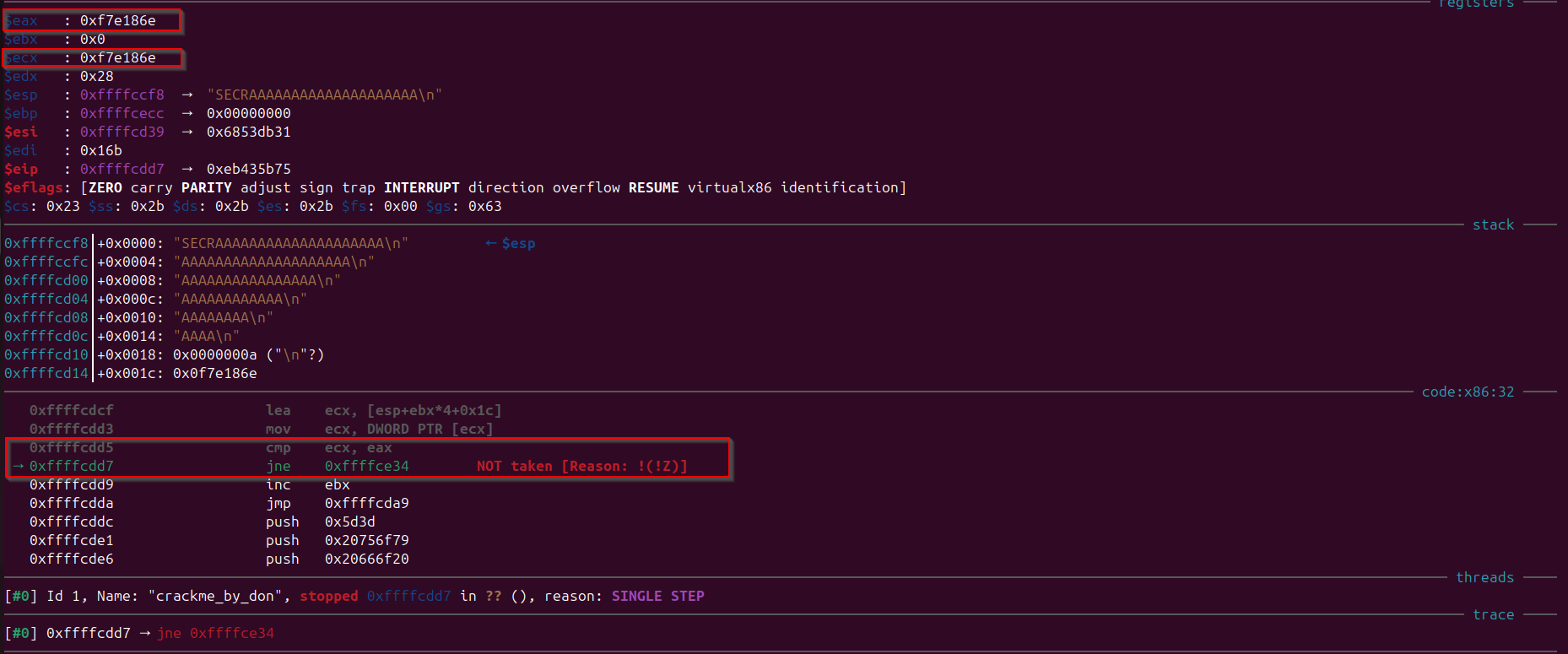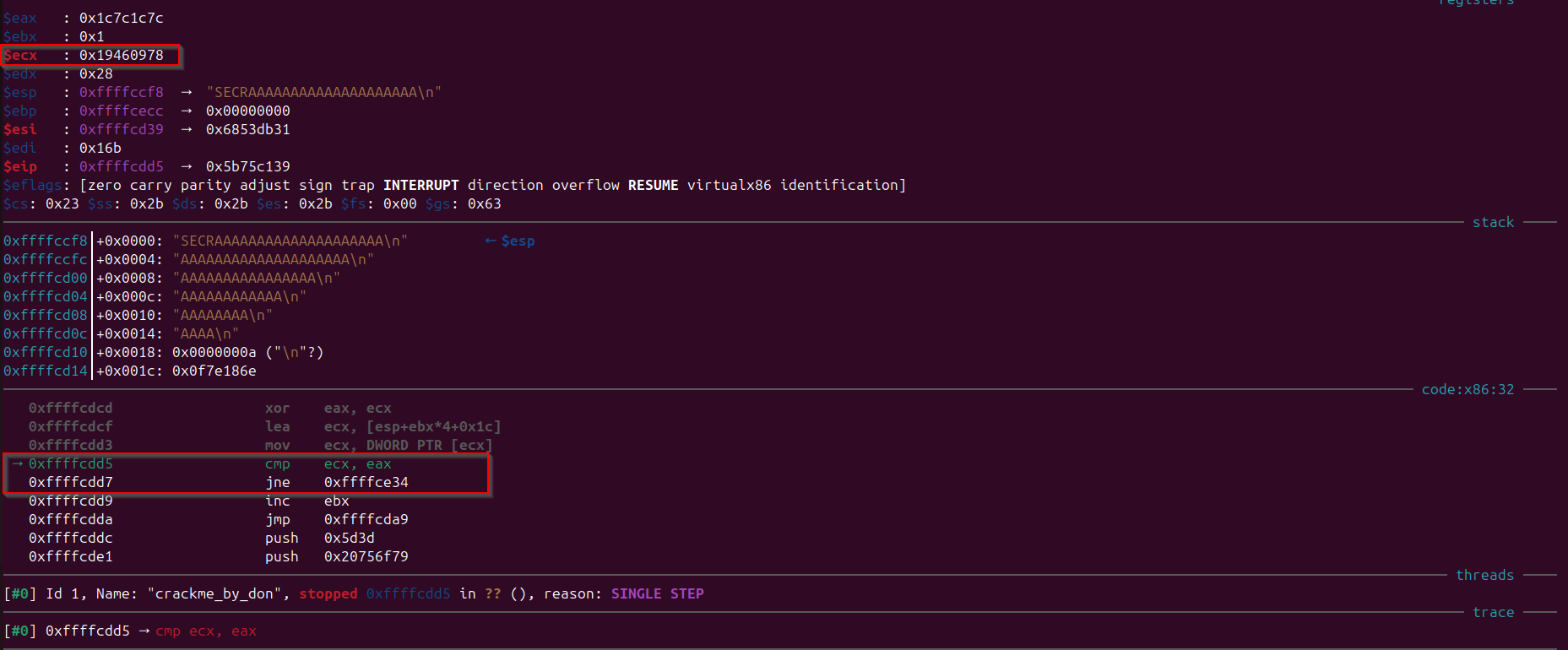Follow the asm
In this reverse engineering challenge we would see that static analysis doesn't provides us that much of info. to solve, so we need to dynamically understand the behaviour of the program, and understand what input exactly it requires, so that we can make our input which is expected and try to solve the challenge.
In this reverse engineering challenge we would see that static analysis doesn’t provides us that much information to solve or move further, so we need to dynamically understand the behavior of the program, and understand what input exactly it requires, so that we can make our input which is expected and try to solve the challenge.
It makes use of the “ebp” register as base and writes the instructions in the stack, later on it makes the execution jump to the stack by making a call to stack address where instructions were stored and from there it would process and compare the user input bytes with the XOR encrypted bytes.
Link to the Challenge: https://crackmes.one/crackme/66fd63059b533b4c22bd0b91
My Linkedin Profile: https://www.linkedin.com/in/deepak-bhardwaj-aa8543143/
My crackme’s profile: https://crackmes.one/user/anon786
This challenge is written in assembly using the NASM and with C, our goal is to find the correct input which will print the success message in the standard output.
Observe that it is an ELF executable.
Let’s run this executable and see, observe that “wrong key” message is getting received in stdout.
Observe that no interesting information could be seen from the “strings” utility.
Observe that if we do “info functions” only 2 functions we could see:
If we will disassemble/de-compile this binary using the ghidra tool, we would observe that it is hard to analyze statically, contains many repeated instructions and after approx. 1000 lines of code, observe that the function pointer is getting assigned with some value and then the function is getting invoked by dereferencing the function pointer and calling the function.
According to me from here (where function pointer is called) the assembly instructions which is written originally by the programmer is getting invoked, where after here it will be all pure assembly instructions which is executing instructions defined in assembly, as the address to the “call” instruction is getting calculated at the run-time.So, while static analysis we will not be able to follow up with the code flow, as the executable code is being referenced in some other locations in the memory.
# Dynamic Analysis:
Lets use “gdb” to analyze what actually is happening, and set the breakpoint at “_start” function:
Note: If we carefully observe the disassembly it can be observed that the using the “ebp” as the base pointer of the current frame of the “_start” function many information is getting written into the stack space.
Let’s see if the “stack” is executable for this program, observe that stack space is “executable” for this binary.
After looking into assembly found the last conditional after the operations were performed in the stack memory region, let’s analyze the last conditional instruction (as before that writing/reading operation is performed in the stack using the “ebx” as the base register), if this condition will be “true” then it will jump in the location which is relative to the “_start” function. And this condition is after the “13579” lines of instructions in the disassembly of “_start” function. Let’s add a breakpoint at that particular instruction:
b *0x5655950b
Observe that once the execution reaches after continuing, observe that the “operand” to the “call” instruction is getting calculated, so the address of the function to call is getting calculated and stored in the “eax” register, initial value of “eax” is 0.
As, we could observe that call is to address in the stack region: 0xffffcd39
And this address in the stack region is pointing to the assembly instructions 0x6853db31, if we decode this 0x6853db31 we would observe that it is assembly instructions for the x86 architecture. If we step into the assembly instructions, after pushing some values into the stack, we would observe that it is making a system call number 3 (which is system call number for read()), lets analyze the values of stack at this point, when it is in the instruction to make system call.
Observe that:
- “eax” value is 3 (which means system call to read()).
- “ebx” value is 0 (which means standard input from which input would be taken).
- “ecx” is holding some location address
0xffffccf8which will store the user input obtained from read() function. - “edx” value is “0x28” (which means 40 max. bytes to be read from stdin).
I have provided input as 30 characters: AAAAAAAAAAAAAAAAAAAAAAAAAAAAAA
Once the user provides the input using “stdin”, then we would observe that the number of bytes read by the system call was returned in the “eax” register and if we observe the assembly in “code” section “eax” getting XORed with “edx” register and then added with “0x11f2”, then some of address is getting stored in the “ebx” register by referring to an address in the data segment (ds) with the offset 0x1223. And then further the value of “eax” and “ebx” is getting compared, based on the comparison if both “eax” and “ebx” will not be equal then execution jumps to the address “0xffffce34”, lets step into the assembly and further observe what is going on. What is the value that is getting stored in “eax”, “ebx”. What is in the address “0xffffce34”.
Register values:
1
2
3
4
5
6
7
8
$eax : 0x1e (30 in decimal)
$ebx : 0x0
$ecx : 0xffffccf8 → 0x41414141 ("AAAA"?)
$edx : 0x28 (40 in decimal)
$esp : 0xffffccf8 → 0x41414141 ("AAAA"?)
$ebp : 0xffffcecc → 0x00000000
$esi : 0xffffcd39 → 0x6853db31
$edi : 0x16b
Code section:
1
2
3
4
5
6
7
0xffffcd8d int 0x80
→ 0xffffcd8f xor eax, edx
0xffffcd91 add eax, 0x11f2
0xffffcd96 lea ebx, ds:0x1223
0xffffcd9c cmp eax, ebx
0xffffcd9e jne 0xffffce34
0xffffcda4 mov ebx, 0x0
It can be observed that in below image, that the “eax” is holding 0x1228 and “ebx” is holding 0x1223 and as both the values were not same after the comparison jump is taken to the address “0xffffce34”, that is pushing some values in the stack, lets step into assembly again and observe where we reaches.
Observe that if we step into assembly and observe that it is the “wrong key exit” condition of the program. Lets save this address 0xffffce34 and whenever we encounter it again we would understand that this is the “wrong key exit” condition.
So, to make sure we don’t hit the “wrong key exit” condition again, we need to make sure that after the input where the “eax” and “ebx” registers were getting compared, they both hold the same value, we can control the value of “eax” register and “ebx” value is obtained from data section. By Observation we could tell that we need to make the value of “eax” same as “ebx” which is 0x1223, so we need to add some value in 0x11f2 to make it equal to 0x1223, if we do math we would know that we need to add 0x31 with 0x11f2 to make it 0x1223 So, we need to make the result of the instruction xor eax, edx as 0x31, as we know that “edx” is holding the value 0x28 and we know result should be 0x31, so by doing XOR of 0x28 ^ 0x31 we would get 0x19, thus now we know that we need to provide 0x19 bytes as input, it means the input length limit on this program is 25 characters. Let’s now provide exactly 25 characters (24 characters and one new line character when we press enter).
1
2
→ 0xffffcd8f xor eax, edx
0xffffcd91 add eax, 0x11f2
Let’s again start the program with the debugger and reach to the execution point where we would provide the input that has length of 24 characters (another character would automatically be included when we press enter): AAAAAAAAAAAAAAAAAAAAAAAAA Observe that “eax” contains 0x19 that is what we wanted, lets continue and see what happens at the comparsion.
Observe that at this time the jump is not taken as both “eax” and “ebx” were equal, and observe that the user input is at the top of the stack “esp”:
Let’s see the current value of registers:
1
2
3
4
5
6
7
8
9
$eax : 0x1223
$ebx : 0xa455
$ecx : 0xffffccf8 → "AAAAAAAAAAAAAAAAAAAAAAAA\n"
$edx : 0x28
$esp : 0xffffccf8 → "AAAAAAAAAAAAAAAAAAAAAAAA\n"
$ebp : 0xffffcecc → 0x00000000
$esi : 0xffffcd39 → 0x6853db31
$edi : 0x16b
$eip : 0xffffcdb5 → 0xf3812574
Let’s see the next assemnly instructions and for refernce I have added the values of registers after these instructions gets executed with comment explained below:
1
2
3
4
5
6
7
8
9
10
11
12
13
14
15
16
cmp eax, ebx
jne 0xffffceb4 --> Not taken as this time we make "eax" and "ebx" equal
mov ebx, 0x0
xor ebx, 0xa455 // No use instruction
cmp ebx, 0xa453 // No use instruction
je 0xffffce5c --> Not taken obviously as "ebx" was not equal to "0xa453"
xor ebx, 0xa455 --> ebx: 0
lea eax, [esp+ebx*4] --> pointing to tos (user input string)
mov eax, DWORD PTR [eax] --> $eax : 0x41414141 ("AAAA"?) // This would move the 4-bytes from address (by dereferncing it) in eax to itself
mov ecx, 0x4c2c4c2c --> $ecx : 0x4c2c4c2c (",L,L"?)
xor ecx, 0x11111111 --> $ecx : 0x5d3d5d3d ("=]=]"?)
xor eax, ecx --> $eax : 0x1c7c1c7c
lea ecx, [esp+ebx*4+0x1c] --> $ecx : 0xffffcd94 → 0x0f7e186e
mov ecx, DWORD PTR [ecx] --> $ecx : 0xf7e186e
cmp ecx, eax --> Comparison of "ecx" and "eax"
jne 0xffffceb4 --> wrong key exit condition
Observe that the “eax” holds the first four bytes of the user input, and “ecx” value after the xor with 0x11111111 becomes 0x5d3d5d3d
# The core logic to extract the correct key
So, from the above assembly instructions, it could be seen that first four characters of the user input is stored in the “eax” register Then 0x4c2c4c2c value is getting moved to “ecx” register, then “ecx” is getting XORed with 0x11111111 which would result in “ecx” to become 0x5d3d5d3d Then further “eax” and “ecx” is getting XORed and result will be stored in “eax”, we know that user input first 4 characters were stored in “eax”.
Then if we observe that some value is getting loaded in the “ecx” register using these instructions:
1
2
0xffffcdcf lea ecx, [esp+ebx*4+0x1c]
0xffffcdd3 mov ecx, DWORD PTR [ecx]
Then this “ecx” value is getting compared with the “eax” value and if they both matches the execution will continue, else if we observe that if “ecx” and “ebx” will not be equal we would jump into the “wrong key” condition and execution will stop.
Note: To extract the correct key, we need to make sure that “ecx” and “eax” match, lets see what value does “ecx” holds which is getting compared with “eax”.
Observe that “ecx” holds the value 0xf7e186e which is getting compared with the “eax” register, but we want these two registers having same value, so how can we make “eax” same as “ecx” This is crucial step that we need to know with which value of “eax” XOR of “ecx” would be done so that the result comes out to 0xf7e186e
1
2
3
4
5
6
7
8
mov ecx, 0x4c2c4c2c --> $ecx : 0x4c2c4c2c (",L,L"?)
xor ecx, 0x11111111 --> $ecx : 0x5d3d5d3d ("=]=]"?) --> We will use this value of "ecx" to XOR with "x0f7e186e"
xor eax, ecx --> $eax : This "eax" value we need to know with what value we need to do XOR so that the result comes out to 0xf7e186e
lea ecx, [esp+ebx*4+0x1c] --> $ecx : 0xffffcd94 → 0x0f7e186e
mov ecx, DWORD PTR [ecx] --> $ecx : 0xf7e186e
cmp ecx, eax --> Comparison of the "eax" and "ecx"
Like previously we could do XOR operation of value stored in “ecx” before XOR with the “eax”, the “ecx” value before was 0x5d3d5d3d and the result 0xf7e186e, so that we can make “eax” equal to 0xf7e186e If we do these 4 hex values “0x0f7e186e” xor with the “0x5d3d5d3d” we get “52434553” which is these 4 characters: RCES
Note: As we know that in x86 architecture data is stored in little endian format, so if we reverse the 4 characters “RCES” we would get “SECR”.
Currently as we have passed the wrong first four characters, we would enter into the jump condition which is the “wrong key” condition. Observe that like previosuly “wrong key” message is getting pushed into stack and execution will stop.
Now as we have our first four characters of the correct key, lets again run this program with providing first four characters as “SECR” and remember that the string needs to be 24 characters, so we will pass: SECRAAAAAAAAAAAAAAAAAAAA Observe that this time comparison is successfull both “eax” and “ecx” value was same and we didn’t went into “wrong key” condition.
Let’s further step into assembly and further try to find the next correct characters for the key. The instructions after stepping into assembly after the successful comparison are (added comments for reference explained below):
1
2
3
4
5
6
7
8
9
10
11
12
13
14
→ 0xffffce29 xor ebx, 0xa455 --> $ebx : 0xa454
0xffffce2f cmp ebx, 0xa453
0xffffce35 je 0xffffce5c --> Not taken
0xffffce37 xor ebx, 0xa455 --> $ebx : 0x1
0xffffce3d lea eax, [esp+ebx*4] --> eax pointing to string starting from 5th character
0xffffce40 mov eax, DWORD PTR [eax] --> This would move the 4-bytes from address (by dereferncing it) in eax to itself
0xffffce42 mov ecx, 0x4c2c4c2c
0xffffce47 xor ecx, 0x11111111
0xffffce4d xor eax, ecx
0xffffce4f lea ecx, [esp+ebx*4+0x1c]
0xffffce50 mov ecx, DWORD PTR [ecx]
→ 0xffffce55 cmp ecx, eax
0xffffce57 jne 0xffffceb4 --> wrong key exit condition
0xffffce59 inc ebx
Again if we observe these instructions are similar just difference is that now “eax” holds the next 4 bytes from the 5th byte of user input, so in “eax” we have “5,6,7,8” characters/byte of user input. Again after below operations we would get the value as 0x5d3d5d3d:
1
2
0xffffce42 mov ecx, 0x4c2c4c2c
0xffffce47 xor ecx, 0x11111111
One more thing is that now the value which is getting stored in “ecx” while execution of below instructions is also getting loaded from different place as now “ebx” is “0x1”, so this time the value would be different:
1
2
0xffffce4f lea ecx, [esp+ebx*4+0x1c]
0xffffce50 mov ecx, DWORD PTR [ecx]
Let’s see what is the value which is getting stored in “ecx” which is finally again getting compared with “eax”.
Observe that the value 0x19460978 is getting stored in the “ecx” that will get compared with the value in “eax”, so like previously we need to do XOR of “ecx” register when the “ecx” register value is calculated using below instructions:
1
2
0xffffce42 mov ecx, 0x4c2c4c2c
0xffffce47 xor ecx, 0x11111111
As the calculated “ecx” value is getting XORed with “eax” which is then getting compared with 0x19460978, so to calculate the “eax” value which would make the XOR of “eax” and “ecx” equal to 0x19460978 So, lets perform XOR of “0x19460978” and “0x5d3d5d3d” which comes out as “0x52434553” which is these 4 characters: is D{TE
If we reverse these 4 characters, we get next 4 correct characters of the key: ET{D So, our key now becomes: SECRET{DAAAAAAAAAAAAAAAA
If we keep on continuing the same we would observe that we are able to get the full correct key required by the program:
1
2
3
4
SECRET{D0n_wAAAAAAAAAAAA --> next 4 correct characters
SECRET{D0n_wtf_dAAAAAAAA --> next 4 correct characters
SECRET{D0n_wtf_did_uAAAA --> next 4 correct characters
SECRET{D0n_wtf_did_u_do} --> Full correct key of length 24
Let’s pass this correct key to our program and observe if we are getting any success message:
This Challenge was amazing….. See you with next one if you are reading.





